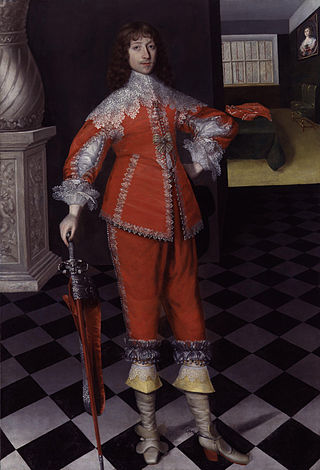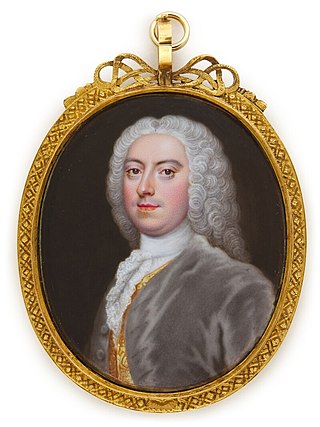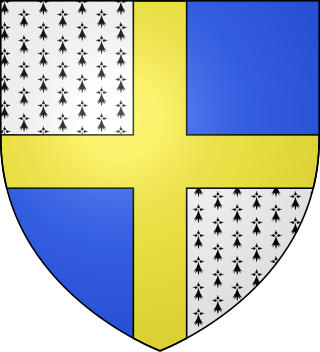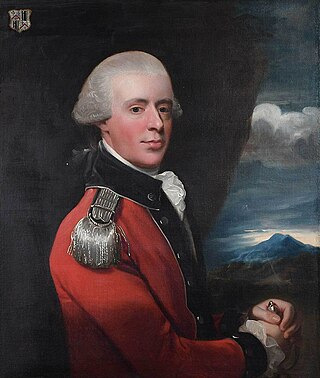
Marquess of Bath is a title in the Peerage of Great Britain. It was created in 1789 for Thomas Thynne, 3rd Viscount Weymouth. The Marquess holds the subsidiary titles Baron Thynne, of Warminster in the County of Wiltshire, and Viscount Weymouth, both created in 1682 in the Peerage of England. He is also a baronet in the Baronetage of England.
Baron Fauconberg is an hereditary title created twice in the Peerage of England.

Viscount Fauconberg, of Henknowle in the Bishopric of Durham, was a title in the Peerage of England held by the head of the Belasyse family. This family descended from Sir Henry Belasyse, High Sheriff of Yorkshire from 1603 to 1604, who was created a Baronet, of Newborough in the County of York, in the Baronetage of England in 1611. His son, Sir Thomas, the second Baronet, was created Baron Fauconberg, of Yarm in the County of York, in the Peerage of England in 1627. In 1643 he was further honoured when he was made Viscount Fauconberg, of Henknowle in the Bishopric of Durham, also in the Peerage of England. He was succeeded by his grandson, Thomas, the second Viscount, the son of Henry Belasyse. Thomas was created Earl Fauconberg in the Peerage of England in 1689. He was childless and the earldom became extinct on his death in 1700. He was succeeded in the remaining titles by his nephew and namesake, Thomas, the third Viscount, the son of Sir Rowland Belasyse. The third Viscount was succeeded by his son, Thomas, the fourth Viscount, who in 1756 was created Earl Fauconberg, of Newborough in the County of York, in the Peerage of Great Britain. The Earl's son Thomas, the second Earl, had no sons and the earldom became extinct on his death in 1802. He was succeeded in the remaining titles by his second cousin Rowland Belasyse, the sixth Viscount, the grandson and namesake of Rowland Belasyse, younger brother of the third Viscount. The sixth Viscount was succeeded by his younger brother, Charles the seventh Viscount, on whose death in 1815 all the titles became extinct.

John Belasyse, 1st Baron Belasyse was an English nobleman, Royalist officer and Member of Parliament, notable for his role during and after the Civil War. He suffered a long spell of imprisonment during the Popish Plot, although he was never brought to trial. From 1671 until his death he lived in Whitton, near Twickenham in Middlesex. Samuel Pepys was impressed by his collection of paintings, which has long since disappeared.

Thomas Belasyse, 1st Earl Fauconberg PC was an English peer. He supported the Parliamentary cause in the English Civil War, becoming close to Oliver Cromwell and marrying Cromwell's third daughter, Mary. After the Restoration of the monarchy he became a member of the Privy Council to Charles II and was elevated to an earldom by William III.
The post of Lord Lieutenant of the North Riding of Yorkshire was created in 1660, at the Restoration. It was abolished on 31 March 1974, and replaced with the office of Lord Lieutenant of North Yorkshire. From 1782 until 1974, all Lords Lieutenant were also Custos Rotulorum of the North Riding of Yorkshire.

Sir Matthew Lamb, 1st Baronet was a British barrister and politician. He was the grandfather of Prime Minister William Lamb, 2nd Viscount Melbourne.

Baron Belasyse was a title that was created twice in the Peerage of England. The first creation came on 27 January 1645 when the Honourable John Belasyse was made Baron Belasyse of Worlaby in the County of Lincoln. He was the second son of Thomas Belasyse, 1st Viscount Fauconberg, the younger brother of the Honourable Henry Belasyse and the uncle of Thomas Belasyse, 1st Earl Fauconberg. He was succeeded by his grandson, Henry, the second Baron, the son of Sir Henry Belasyse, who was killed in a duel in 1667. The title became extinct when the second Baron died childless in 1691.

Newburgh Priory is a Grade 1 listed Tudor building near Coxwold, North Yorkshire, England.
Sir George Wombwell, 1st Baronet was Chairman of the Honourable East India Company and a Member of Parliament.
Thomas Belasyse, 1st Viscount Fauconberg, styled Baron Fauconberg between 1627 and 1643 and Sir Thomas Belasyse, 2nd Baronet between 1624 and 1627, was an English politician who sat in the House of Commons at various times between 1597 and 1624 and was raised to the peerage in 1627. He was an ardent supporter of the Royalist cause in the English Civil War.

Sir Edward Osborne, 1st Baronet, of Kiveton was an English politician who sat in the House of Commons at various times between 1628 and 1640.

George Saunderson, 5th Viscount Castleton was an English soldier and politician who sat in the House of Commons from 1660 to 1698.
Sir Thomas Ingram was an English politician who sat in the House of Commons in two periods between 1640 and 1672. He supported the Royalist cause in the English Civil War.

Sir Henry Belasyse, 1st Baronet (1555–1624) was an English politician.
Henry Belasyse or Bellasis may refer to:

Sir George Wombwell, 2nd Baronet was an English first-class cricketer with amateur status who played for the Marylebone Cricket Club.
Thomas Belasyse, 1st Earl Fauconberg was a British peer.

Henry Belasyse, 2nd Earl Fauconberg was a British politician and peer.

Sir George Wombwell, 3rd Baronet was a British baronet.












